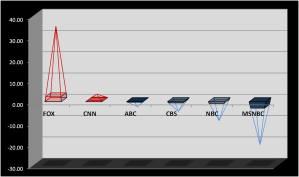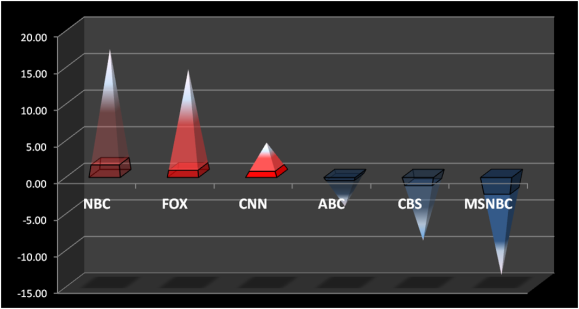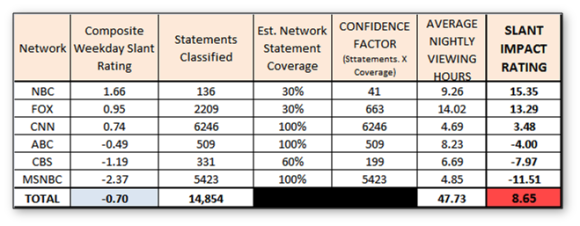Is there a liberal bias (or as we prefer to call it, political news slant) in the U.S media? It depends largely on which news content you think matters most.
Based on the data we currently have under analysis, early indications are that the leading broadcast and cable new outlets lean towards the Democratic party. With that said, the recently released Pew Research Center News Interest Index indicates that more people are now turning to cable news for information about the 2012 presidential campaign than to other forms of media. Adjusting for their findings yields an entirely different result.
For Impact Report #2, we have quantified the amount of network slant (aggregate speaker bias plus editorial influence) and combined it with viewership data in order to assess the total “Impact.” In this installment, we have computed the weighted-average Impact Rating for each network during the weeks of January 16th and January 23rd, focused on their evening/weekday news programming. The results are depicted below:
As in all of our charts, content favoring the Republican party is represented in red (greater than zero), while that which leans towards the Democratic Party is shown in blue (less than zero). We have indicated depth-of-coverage by lightening the base colors as required. For example, the bases representing NBC,CBS, and to a lesser degree Fox News, were purposely made lighter to reflect the limited transcript coverage for those particular networks. Regardless, the basic message depicted in chart above is that the slant rating base is amplified by the number of people viewing the content. The table below shows the numerical analysis supporting the chart:
The Cumulative  Slant Ratings in column 2 were derived from data previously discussed and shown at this site on Wednesday, February 8th. We have also factored in viewership data for the networks and programs under review. As you can see, the cumulative rating for this report — across all networks and programs we are studying — slightly favors Democrats/Liberals, as indicated by the numbers highlighted in light blue.
Slant Ratings in column 2 were derived from data previously discussed and shown at this site on Wednesday, February 8th. We have also factored in viewership data for the networks and programs under review. As you can see, the cumulative rating for this report — across all networks and programs we are studying — slightly favors Democrats/Liberals, as indicated by the numbers highlighted in light blue.
 If, however, we account for the Pew Research data, which states that 36% of people regularly go to cable networks to learn about Presidential campaigns (and, we presume, national political news in general) versus only 26% turning to national nightly news programs, our cumulative results shift in favor of Republican/conservative interests (as highlighted in light red).
If, however, we account for the Pew Research data, which states that 36% of people regularly go to cable networks to learn about Presidential campaigns (and, we presume, national political news in general) versus only 26% turning to national nightly news programs, our cumulative results shift in favor of Republican/conservative interests (as highlighted in light red).
Liberal or conservative media bias? It all depends on whose news one views.












